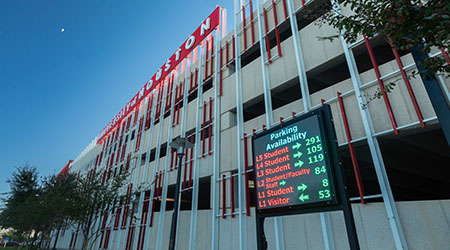 PCGS Wayfinding Sign at University of HoustonWalter P Moore
PCGS Wayfinding Sign at University of HoustonWalter P MooreSpace Available for Parking System’s Growth
Defining three types of parking systems and how they fit specific parking facilities.
Parking count systems and parking guidance systems in various forms have been around the parking industry for some time. In order to better comprehend how a parking guidance system can be utilized in a parking facility, we must first understand the three predominant types of systems and how each are utilized for different user groups and types of parking facilities.
1. Facility Parking Count System
The entry level system is generally referred to as a parking facility count system. These types of systems utilize either the barrier gates and/or a bi-directional counting mechanism located at each ingress and egress lane to the facility. The cost for these types of systems can run approximately $20,000 per lane, which includes the sensors/loops, counting software, and a basic lot open/full sign. This entry system is less accurate and requires daily calibration, which adds additional labor costs to the parking facility operating expenses. The need for daily calibration comes from less-than-ideal accuracy levels of 90 percent to 93 percent that can compound daily without proper calibration. The ideal parking facility to utilize this type of system would be a small parking structure — less than 500 parking spaces — with a single helix ramping system and two-way traffic patterns.
Additionally, the parking facility should be no more than two bays in width. The combination of the ramp, two-way traffic patterns, and width of the garage allows the user to pass every parking space in the parking facility, negating the need for more advanced parking guidance systems. Some owners and parking operators prefer an entry-level guidance system to inform customers of the general availability of parking within the facility as either open or full and are less concerned about guiding them to the first, or last, available parking space.
Parking facility count systems by nature are very basic and provide limited information. However, some integration opportunities exist with the ability to share parking facility status, such as open or closed, with third-party applications and/or in-house parking access control applications. For example, if a parking facility reaches capacity and is verified through the facility count system, it can send the information to the building management system to alert security to close the facility and update the signage to direct patrons to other parking facilities.
2. By Level Parking Count and Guidance
A mid-level parking guidance system utilizes the same type of technology as the entry level system but adds additional locations that count vehicle movements within the facility and variable message signs to indicate the number of available parking spaces at each level. This type of system is generally referred to as a by level parking count and guidance system. As the name implies, counting mechanisms such as inductance loops or ultrasonic sensors located at the entry and exit portals indicate how many vehicles entered and exited each level compared to how many spaces are available.
Additionally, this type of system provides general information indicating how many spaces are available on each level of a facility through the use of variable message signs located at each entry portal to the facility as well as variable message signs located at the entry to each parking level.
A by level parking count and guidance system is most appropriate for larger parking facilities where the user does not pass every parking space as they traverse the parking structure. In the recent past, many airport parking structures have implemented this type of system to provide basic parking availability to the user on a by level basis. Because the system architecture is based on bi-directional counting mechanisms located within traffic lanes, it also suffers from accuracy and reliability challenges. For a larger parking facility to achieve the intended purpose of accurately guiding patrons to levels with available parking, the system must be calibrated daily. Larger parking facilities — over 2,000 parking spaces — sometimes must calibrate twice a day. As a result, the labor cost can be quite a challenge during the daily or twice daily calibration.
The general cost structure of these systems is around the same as facility count systems and are generally priced on a per lane basis at approximately $20,000 per lane. As an example, a 9-level parking structure that contains 2,500 parking spaces and utilizes an express ramp system contains approximately 22 lanes. At an approximate cost of $20,000 per lane this would equate to a total system cost of approximately $440,000. (This figure takes into account a rough reduction in cost for economy of scale over the smaller parking structure with the same per lane cost, and adds in the cost of the variable message signs at each level and display boards at each entry location to the facility. The probable cost roughly equates to approximately $180 per parking space.)
Integration opportunities are also limited with this type of system, but some manufactures can interface with the facility parking access and revenue control system (PARCS). As the facility begins to reach a preset capacity/occupancy level, it can communicate with the PARCS to manage access and prevent additional vehicles until the occupancy dips back below acceptable levels.
3. By Space Parking Count and Guidance
The premier parking count and guidance system is generally referred to as a by space parking count and guidance system (PCGS). This system includes sensors that monitor each individual parking space by means of ultrasonic or camera-based technology. The main benefit of this type of system is the ability to guide parking patrons to the first and last available parking space in the facility. Dynamic wayfinding signs are located throughout the parking structure at each major decision point.
In addition to enhanced wayfinding, by space parking count and guidance systems increase the average utilization of the parking structure by upwards of 10 percent. In large parking structures, without a parking count and guidance system, parking operators generally close the facility once occupancy approaches 85 percent to 90 percent. The last remaining parking spaces in this scenario are very difficult to locate and can cause much frustration for patrons and operators alike. A PCGS can allow a parking facility to achieve close to 100 percent utilization without a severe reduction in customer satisfaction.
A by space parking count and guidance system is appropriate for both large and small parking structures alike where enhanced wayfinding is required, and monitoring of parking turnover is desired to understand parking trends over time. Understanding trends such as occupancy during peak times can help operators predict when to expect increased traffic and demand for parking spaces. In the early part of this decade this type of system was predominately used in airport parking structures to help patrons find available parking quickly, especially during peak travel seasons.
As the popularity of the by space parking count and guidance systems grew, many other markets such as retail, commercial office, higher education, and healthcare institutions began to take notice on how these systems can help their parking operations. All of these vertical markets have differing goals and reasons for implementing a PCGS in their parking facility, but all agree that enhancing the customer and/or employee experience was the main reason for selecting a by space parking count and guidance system.
The cost of a PCGS can vary depending on the level of wayfinding signage needed and the complexity of the parking structure. Using the same example from above, a 2,500-space parking garage with single space monitoring can run in the range of $450 to $650 per each parking space. For a 2,500-space parking garage the cost can range from $1.1M to $1.6M for initial cost. Ongoing costs can include the cost for the vendor to host data and preventative maintenance. The additional benefit is the virtual elimination of labor cost to calibrate the system daily. Accuracy and reliability with these systems, depending on the vendor, is upwards of 99 percent.
The Future
There are several integration opportunities available with a by space parking count and guidance system. Some PCGS manufacturers are currently testing technology to utilize their sensor cameras to not only monitor each individual parking space for availability, but to also interface with the parking facility surveillance system to provide additional monitoring capabilities at each individual parking space. Lighting systems can also be integrated with some PCGS systems to provide active lighting management to save on operating cost.
As autonomous vehicles get a little closer to reality, a PCGS system can inform a third-party application that its parking structure has available parking and can provide the exact location of available parking spaces. Additionally, in the near future, parking operators can receive an alert from a PCGS that is monitoring electric vehicle (EV) charging stations that the car currently occupying the station has overstayed their welcome. An alert can be sent from the PCGS to the EV station application notifying the owner to either move their vehicle or be subject to additional parking fees.
The outlook for integration possibilities are endless, and the future is bright for parking owners and operators that embrace technology such as parking count and guidance systems.
Brian Lozano (blozano@walterpmoore.com) is a principal and director of parking at Walter P Moore.
Related Topics:












